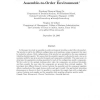Free Online Productivity Tools
i2Speak
i2Symbol
i2OCR
iTex2Img
iWeb2Print
iWeb2Shot
i2Type
iPdf2Split
iPdf2Merge
i2Bopomofo
i2Arabic
i2Style
i2Image
i2PDF
iLatex2Rtf
Sci2ools
EOR
2008
2008
Coordination of stocking decisions in an assemble-to-order environment
In this paper we study an assemble-to-order environment involving a short-life-cycle product. The product is sold in two different configurations, each requiring a unique component that must be stocked in advance. Both configurations of the product are assembled on the same equipment which has limited capacity. We assume that the assembly capacity is allocated in such a way as to maximize profit for any given product demands and components availability. The main issue is to determine the appropriate stocking quantities for each of the configuration specific components. We first solve for the optimal stocking policy when the components are produced internally, and then consider the case when the components are procured from external suppliers. We investigate how different forms of contract between the assembler and the component suppliers affects coordination of the supply chain as well as each party's profit. One particularly interesting phenomenon we discover is that it is possi...
| Added | 10 Dec 2010 |
| Updated | 10 Dec 2010 |
| Type | Journal |
| Year | 2008 |
| Where | EOR |
| Authors | Xiaohong Zhang, Jihong Ou, Stephen M. Gilbert |
Comments (0)

